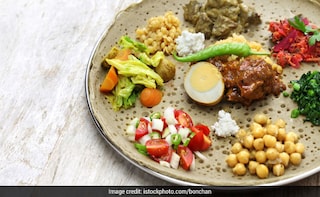The day I told my friends I was travelling to Ethiopia is the day I learned that Ethiopian food is The Next Big Thing. "Oh my god, you're going to Ethiopia!" they gushed. "The food is excellent! How lucky you are!" I thought this was remarkable in a country (and city) that hasn't shown much interest in any sort of African cuisine at all. As far as I know, Mumbai has a couple of Nigerian restaurants, which are mostly patronised by visiting Nigerians, and that's it. I also remember reading about an Ethiopian food popup hosted by an Indian lady, but that seemed to be about the end of the matter.
Garlic, shallots, ginger and onions too, make their way into many gravy dishes, making for a rather familiar eating experience. There is no pussy-footing here; the flavours are pulsing, complex and layered, but strong. Spicy really does mean spicy here!Cook Like An IndianThere is no doubt that the Ethiopians are a meat-loving nation. Beef and mutton feature heavily in their meals: for instance, kitfo, available almost everywhere, is raw beef, roughly chopped with African birds eye chillies and nitre kibbeh (which is a sort of spiced ghee, another Indian connection); there is Menchet Abesh, which is spicy minced beef stew; Awaze lamb, which is lamb fuelled by berbere.
Vegetarian food is often relegated to the margins of the meal, if at all. However, there is a time when it takes precedence, and that is during fasts. In fact, a lot of menus carry their vegetarian food under the name Fasting Food. Vegetables are not as abundant in Ethiopia as they are here, but you get plenty of cabbage, sugar-sweet crimson beetroot, dark, leafy gomen (a type of collard green, perhaps?), and carrots, cooked until they soften and relax. In the restaurants I travelled to, the availability of Fasting Food was a wobbly thing though; available constantly before Christmas (it is celebrated as per the Orthodox Christian calendar in January, and many people fast devoutly for it), and uncertain after.Lentils are available everywhere. Deffen misir alicha, softened lentils suggesting a dal of sorts, and the racy misir wot, red lentils smouldering in a berbere paste, were sold often and everywhere.
About the Author:Meher Mirza is an independent writer and editor, with a focus on food and travel. Formerly with BBC Good Food India, she loves anime, animals and artsy things but also comics, technology and death metal.Disclaimer:The opinions expressed within this article are the personal opinions of the author. NDTV is not responsible for the accuracy, completeness, suitability, or validity of any information on this article. All information is provided on an as-is basis. The information, facts or opinions appearing in the article do not reflect the views of NDTV and NDTV does not assume any responsibility or liability for the same.
Garlic, shallots, ginger and onions too, make their way into many gravy dishes, making for a rather familiar eating experience. There is no pussy-footing here; the flavours are pulsing, complex and layered, but strong. Spicy really does mean spicy here!
Advertisement
Vegetarian food is often relegated to the margins of the meal, if at all. However, there is a time when it takes precedence, and that is during fasts. In fact, a lot of menus carry their vegetarian food under the name Fasting Food. Vegetables are not as abundant in Ethiopia as they are here, but you get plenty of cabbage, sugar-sweet crimson beetroot, dark, leafy gomen (a type of collard green, perhaps?), and carrots, cooked until they soften and relax. In the restaurants I travelled to, the availability of Fasting Food was a wobbly thing though; available constantly before Christmas (it is celebrated as per the Orthodox Christian calendar in January, and many people fast devoutly for it), and uncertain after.
Advertisement
Advertisement
About the Author:
Advertisement
For the latest food news, health tips and recipes, like us on Facebook or follow us on Twitter and YouTube.
Advertisement
